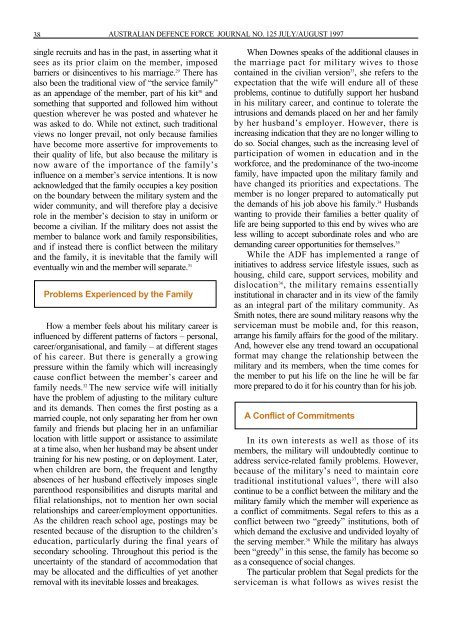ISSUE 125 : Jul/Aug - 1997 - Australian Defence Force Journal
ISSUE 125 : Jul/Aug - 1997 - Australian Defence Force Journal
ISSUE 125 : Jul/Aug - 1997 - Australian Defence Force Journal
Create successful ePaper yourself
Turn your PDF publications into a flip-book with our unique Google optimized e-Paper software.
38AUSTRALIAN DEFENCE FORCE JOURNAL NO. <strong>125</strong> JULY/AUGUST <strong>1997</strong>single recruits and has in the past, in asserting what itsees as its prior claim on the member, imposedbarriers or disincentives to his marriage. 29 There hasalso been the traditional view of “the service family”as an appendage of the member, part of his kit 30 andsomething that supported and followed him withoutquestion wherever he was posted and whatever hewas asked to do. While not extinct, such traditionalviews no longer prevail, not only because familieshave become more assertive for improvements totheir quality of life, but also because the military isnow aware of the importance of the family’sinfluence on a member’s service intentions. It is nowacknowledged that the family occupies a key positionon the boundary between the military system and thewider community, and will therefore play a decisiverole in the member’s decision to stay in uniform orbecome a civilian. If the military does not assist themember to balance work and family responsibilities,and if instead there is conflict between the militaryand the family, it is inevitable that the family willeventually win and the member will separate. 31Problems Experienced by the FamilyHow a member feels about his military career isinfluenced by different patterns of factors – personal,career/organisational, and family – at different stagesof his career. But there is generally a growingpressure within the family which will increasinglycause conflict between the member’s career andfamily needs. 32 The new service wife will initiallyhave the problem of adjusting to the military cultureand its demands. Then comes the first posting as amarried couple, not only separating her from her ownfamily and friends but placing her in an unfamiliarlocation with little support or assistance to assimilateat a time also, when her husband may be absent undertraining for his new posting, or on deployment. Later,when children are born, the frequent and lengthyabsences of her husband effectively imposes singleparenthood responsibilities and disrupts marital andfilial relationships, not to mention her own socialrelationships and career/employment opportunities.As the children reach school age, postings may beresented because of the disruption to the children’seducation, particularly during the final years ofsecondary schooling. Throughout this period is theuncertainty of the standard of accommodation thatmay be allocated and the difficulties of yet anotherremoval with its inevitable losses and breakages.When Downes speaks of the additional clauses inthe marriage pact for military wives to thosecontained in the civilian version 33 , she refers to theexpectation that the wife will endure all of theseproblems, continue to dutifully support her husbandin his military career, and continue to tolerate theintrusions and demands placed on her and her familyby her husband’s employer. However, there isincreasing indication that they are no longer willing todo so. Social changes, such as the increasing level ofparticipation of women in education and in theworkforce, and the predominance of the two-incomefamily, have impacted upon the military family andhave changed its priorities and expectations. Themember is no longer prepared to automatically putthe demands of his job above his family. 34 Husbandswanting to provide their families a better quality oflife are being supported to this end by wives who areless willing to accept subordinate roles and who aredemanding career opportunities for themselves. 35While the ADF has implemented a range ofinitiatives to address service lifestyle issues, such ashousing, child care, support services, mobility anddislocation 36 , the military remains essentiallyinstitutional in character and in its view of the familyas an integral part of the military community. AsSmith notes, there are sound military reasons why theserviceman must be mobile and, for this reason,arrange his family affairs for the good of the military.And, however else any trend toward an occupationalformat may change the relationship between themilitary and its members, when the time comes forthe member to put his life on the line he will be farmore prepared to do it for his country than for his job.A Conflict of CommitmentsIn its own interests as well as those of itsmembers, the military will undoubtedly continue toaddress service-related family problems. However,because of the military’s need to maintain coretraditional institutional values 37 , there will alsocontinue to be a conflict between the military and themilitary family which the member will experience asa conflict of commitments. Segal refers to this as aconflict between two “greedy” institutions, both ofwhich demand the exclusive and undivided loyalty ofthe serving member. 38 While the military has alwaysbeen “greedy” in this sense, the family has become soas a consequence of social changes.The particular problem that Segal predicts for theserviceman is what follows as wives resist the
















